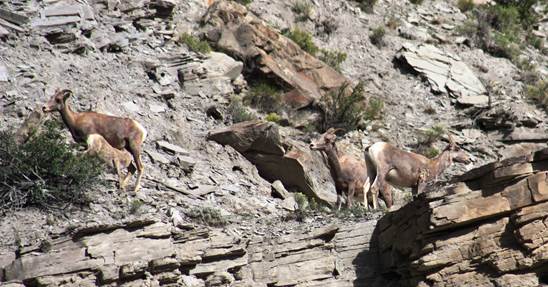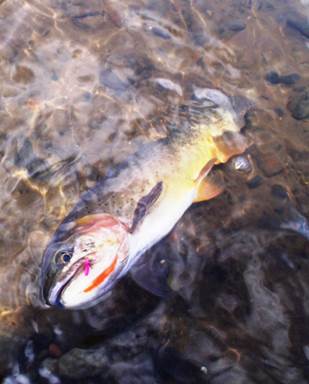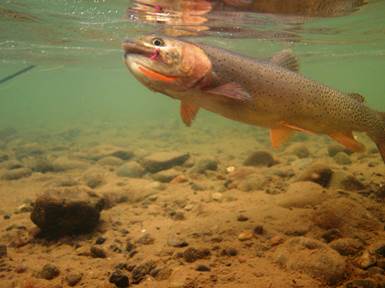THE FLY FISHING CHRONICLES OF YELLOWSTONE NATIONAL PARK – PART 3
| Sysadmin Note |
|---|
| Part 2 can be found here |

In late August through early September this is the time period that I want to on the Lamar River as often as I can and the reason is simple as this is the time period when the massive flights of ants appear on the water. Before I delve into any of the fishing days that I have enjoyed on the Lamar River I wish to discuss the importance of ants to both the angler and the trout. One should never forget that the wonder and beauty of the park, this morning as we came into the park heading for the Larmar we found the Big Horn Sheep out and about along the Gardiner River, and we stopped for photographs and then resumed are journey.
Many of the terrestrial food forms are only available during limited or specific time periods. Ants, however, are available to the trout from April to October. There are several colors and sizes of ants, from large carpenter ants to tiny, reddish brown flying ants. Many anglers refuse to fish ants because they can't see them. If this is your problem, simply fish the ant as a dropper behind a pattern that you can see.
Many anglers ask, "When should ants be used?" We, as a people, seem to like things in very neat and ordered categories, and because of this we often fail to realize the natural happenings on streams; thus we lose some very good and interesting fishing opportunities. This happens when we become too rigid in our thinking and fail to observe. Trout often feed opportunistically on terrestrial food forms, and during the warm months of the year most streams have a constant Terrestrial Drift going on. Not only will this drift activity bring surface rises, it will also induce subsurface activity. Ants, being very active and extremely numerous, often end up in the water as part of the terrestrial drift. Therefore, employing the use of ant imitations, both wet and dry, during the warm weather time periods of April to October is an excellent choice.
Anytime there are super heavy numbers of ants on the water, the trout can, and will, become selective to the ants. This is just like fishing any other hatch. Work the feeding trout using good presentation methods and good imitative patterns.
Often the observant angler will find a trout or two stationed in a feeding zone where they are seeing a lot of ants, even when other trout may be seeing none or only a few. These trout can be quite fussy, and may only take a properly presented ant imitation. During the slack times of the day I like to use a two fly system, fishing both a dry ant and a wet ant.
Many anglers fail to consider wet ant imitations. Well, remember wet ant patterns were effective for hundreds of years before the coming of the dry fly. Many think only of the dry ant and think that ants float forever and never end up under the water. Nothing could be further from the truth. They do end up subsurface, just like everything else that fall into the water. Therefore, it stands to reason that if the trout will rise to the surface to feed on the floating ant, it will also feed on the drowned, subsurface ant. That is why I use the wet/dry two fly system.
ANTS
Class: Insecta
Order: Hymenoptera
Suborder: Apocrita
Super Family: Vespoidea
Family: Formicidae
Ants are cousins to the related families of bees and wasps and together they form the Order Hymenoptera, which is a very diverse group of insects with more than 12,000 individual species. The Family: Formicidae has some 22 Sub Families.
There are also some insects which appear to be ants, but are not. Termites are often referred to as White Ants. Velvet Ants, although resembling large ants, really are a wingless wasp, though I doubt that the trout care!
Studies have shown that ants can make up 15% to 23% of the terrestrial insect biomass. Ants are found along every trout stream in America. As a side note, ants are found nearly worldwide with just a few exceptions. You don't have to worry about ant imitations if you are fishing those frozen trout streams of Antarctica, Greenland or Iceland or parts of Polynesia and other remote islands.
As a general point of information, many anglers feel that terrestrials are only important on breezy days. Nothing could be further from the truth. Terrestrials are always falling off the bank and into the water for a number of reasons. I like to think that in most cases it was just bad judgment on the part of the terrestrial in question.
Yes, the wind can blow them in, but that is not the only way they find themselves in the water and a part of the daily diet of the trout. Ants fall into two major categories, carnivorous and scavengers. Thus they are always out and about looking for a meal, often times along the banks of a stream, where all it takes is misstep and they are on the trout's dinner list.
Notes on Flying Ants
On certain trout streams, every year, around the same time period the anglers and the trout enjoy a three to six day period where flying ants litter the water. Normally this occurs during the late summer or early fall.
Ants are a very social insect with a complex order. As the time for mating occurs, the males and female of the colony begin mating flights. Normally the females are larger than the males. However, the males outnumber the females by a considerable margin. On a side note - once the mating is complete, the females (queens) drop to the ground, lose their wings and try to begin a colony.
If there is water around the swarming insects they seem to be attracted to it, like moth to a light. I am sure that there is some reasonable scientific reason for this, but I have yet to discover it and the reason is not relative to trout fishing. When the ants litter the water it is like fishing another hatch or flight the angler might encounter. Use good imitations, careful approach and proper presentation methods and you will be successful.
One final word of advice when choosing an ant imitation as a searching pattern - use larger imitations, from size 10 to 16. The smaller sized imitations always work the best during specific angling situations but the larger imitation are better as a searching pattern and they sure are easier to see on the water.
Now, back to fishing on the Lamar River. Today I am not guiding but here fishing with my long time fishing partner Paul Gates. We arrive on the river about 9 A.M. and drove to the about 1½ miles downstream from the junction of the Lamar River and Soda Butte Creek which is where the picnic area use to be. At this point the river makes a bend and runs right toward the road and then makes another bend and runs right along the road.
Admittedly it is an obvious place to fish and sees a lot of anglers however over the years I have seldom had to wait very long to fish this section of the river and most of the anglers go through this water like starving man on the way to free lunch. As we pulled into the parking area Paul noted that there was an angler in the area that I wanted to fish but by the time we had gear up and walked down to the river he was gone.
There is a nice riffle that empties into pool and on this morning I sat along the bank and watched the water, I noticed that the trout were begin to feed and I knew that they were feeding on tanish brown fly ants about a size 16 as several had landed on me. As there were several nice trout feeding in the riffle and at the base of the riffle I choose as size 14 tan foam ant. I figured with the faster water they would not be keyed into size and this proved to be the case as over the next two and half hours I just had a great time. Paul had gone downstream and worked back toward my position and reported the same action on the same pattern. We decided that now would be a good time to take a lunch break.
After lunch Paul headed upstream as I returned to the riffle and pool. At present time there were no insects on the water so choose a Mini Chernobyl Black Ant size 12 and trailed a size 14 Hot Pink Foam Ant on a dropper 20". In this case I was prospecting as there were no visible trout feeding, the first Cutthroat rose at the base of the riffle and I noticed that the Hot Pink Ant was the fly taken. During the afternoon I took several more Cutthroat Trout on that same Hot Pink Foam Ant, Paul finally returned and found me in the same pool that I had started day fishing. We then headed for the truck to move up to Soda Butte Creek for the rest of the day, I showed him the pictures of the Cutthroat with the Hot Pink Ant and gave him a couple to try on another day.


WB Pink Ant
- Hook: Dai-Riki#125 or TMC 101 Sizes: 12-18
- Thread: 12/0 Black
- Body: Pink Dry Cell Foam
- Hackle: Black, dry fly, trimmed on the bottom
Note: The WB stands for Wild Bunch a name that seems to fit, as I show these flies to angler I get a lot of "You have got to be kidding, trout will really eat that wild pink thing!" yep they sure do and soon many of them have become believers in the Wild Bunch Hot Pink Ant and some of the other wild colors that I use. They are sure easier to see on the water so give them a try and try some wild colors of your own.
Enjoy & Good Fishin
| Sysadmin Note |
|---|
| Part 4 can be found here |
